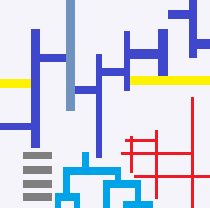# -*- coding: utf-8 -*-
"""
Various functions about :epkg:`blockdiag`.
.. versionadded:: 1.1
:githublink:`%|py|8`
"""
import os
import io
import glob
[docs]def _create_fontmap(fontmap, font):
"""
Inspired from :epkg:`blockdiag` source file (*_bootstrap.py*).
:githublink:`%|py|16`
"""
from blockdiag.utils.fontmap import FontMap
fontmap = FontMap(fontmap)
if fontmap.find().path is None or font:
fontpath = _detectfont(font)
fontmap.set_default_font(fontpath)
return fontmap
[docs]def _build_diagram(module, builder, drawer, tree, type, code,
fontmap=None, antialias=True, nodoctype=False,
transparency=False, size=None):
"""
Inspired from :epkg:`blockdiag` source file (*_bootstrap.py*).
:githublink:`%|py|30`
"""
ScreenNodeBuilder = builder.ScreenNodeBuilder
diagram = ScreenNodeBuilder.build(tree, None)
DiagramDraw = drawer.DiagramDraw
drawer = DiagramDraw(type, diagram, fontmap=fontmap,
code=code, antialias=antialias,
nodoctype=nodoctype, transparency=transparency)
drawer.draw()
if size:
return drawer.save(size=size)
else:
return drawer.save()
[docs]def _detectfont(font):
fontdirs = [
'/usr/share/fonts',
'/Library/Fonts',
'/System/Library/Fonts',
'c:/windows/fonts',
'/usr/local/share/font-*',
]
fontfiles = [
'ipagp.ttf',
'ipagp.otf',
'VL-PGothic-Regular.ttf',
'Hiragino Sans GB W3.otf',
'AppleGothic.ttf',
'msgothic.ttf',
'msgoth04.ttf',
'msgothic.ttc',
]
fontpath = None
if font:
from blockdiag.utils.fontmap import parse_fontpath
for path in font:
_path, _ = parse_fontpath(path)
if os.path.isfile(_path):
fontpath = path
break
else:
msg = 'fontfile is not found: %s' % font
raise RuntimeError(msg)
if fontpath is None:
globber = (glob.glob(d) for d in fontdirs)
for fontdir in sum(globber, []):
for root, _, files in os.walk(fontdir):
for font_ in fontfiles:
if font_ in files:
fontpath = os.path.join(root, font_)
break
return fontpath
[docs]def draw_diagram(graph, module="blockdiag", format="pillow", **options):
"""
Draws a graph based on module :epkg:`blockdiag`.
:param graph: graph definition,
see `syntax <http://blockdiag.com/en/blockdiag/examples.html>`_
:param module: ``'blockdiag'`` (only available value)
:param format: can be a filename or a module name (``'pillow'``)
:param options: additional options for :epkg:`blockdiag`
:return: graph
::
blockdiag {
A -> B -> C -> D;
A -> E -> F -> G;
}
See notebook :ref:`drawdiagramrst`.
:githublink:`%|py|108`
"""
if module == "blockdiag":
import blockdiag # pylint: disable=C0415
module = blockdiag
import blockdiag.parser # pylint: disable=C0415
parser = blockdiag.parser
import blockdiag.builder # pylint: disable=C0415
builder = blockdiag.builder
import blockdiag.drawer # pylint: disable=C0415
drawer = blockdiag.drawer
else:
raise ValueError(
"Unexected value for 'blockdiag': '{0}'".format(module))
if format in ("pillow", "png"):
ftype = "png"
elif format == "svg":
ftype = "svg"
else:
raise ValueError("format should in ['pillow', 'svg']")
fontmap = _create_fontmap(fontmap=options.get('fontmap', None),
font=options.get('font', None))
tree = parser.parse_string(graph)
res = _build_diagram(module=module, builder=builder, drawer=drawer,
tree=tree, code=graph, fontmap=fontmap, type=ftype,
antialias=options.get('antialias', True),
nodoctype=options.get('nodoctype', False),
transparency=options.get('transparency', False),
size=options.get('size', None))
if format == "pillow":
from PIL import Image
image = Image.open(io.BytesIO(res))
return image
else:
return res
